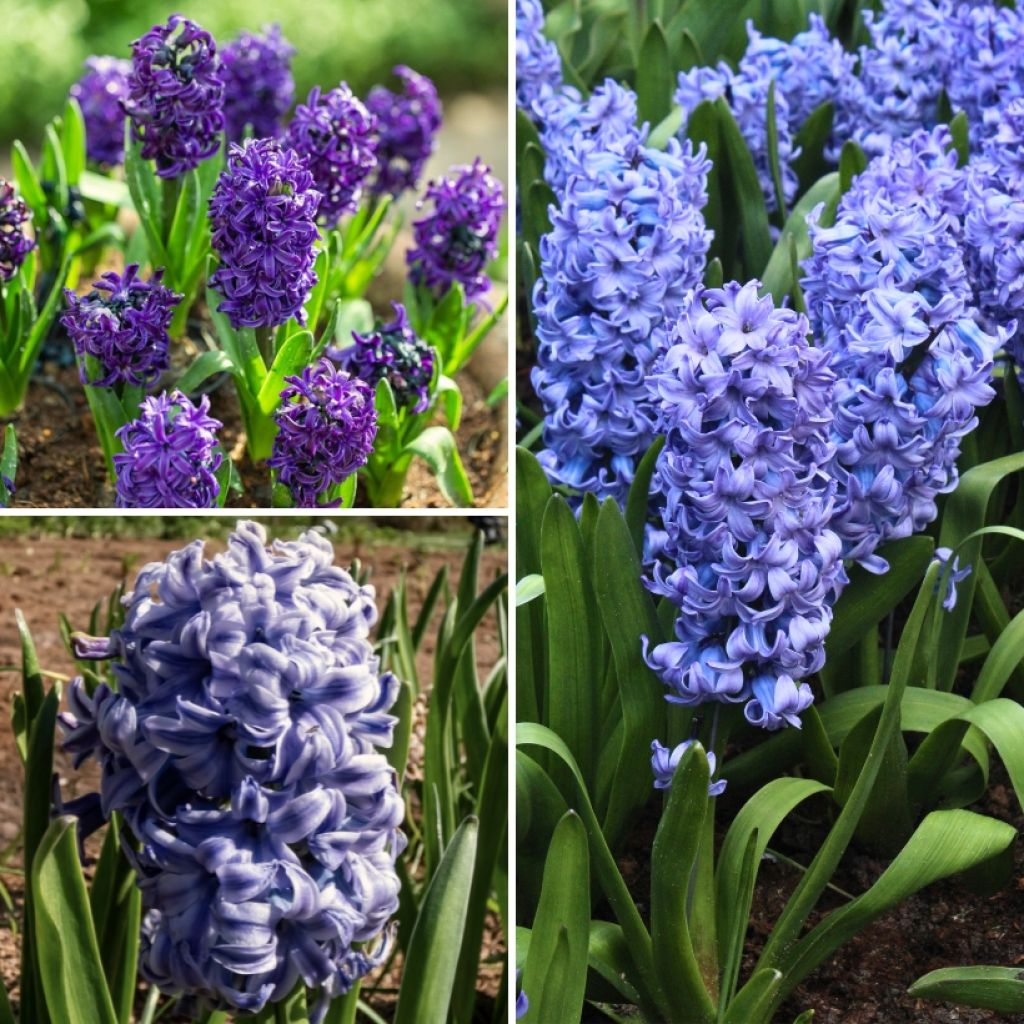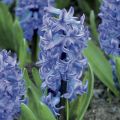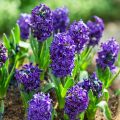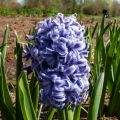

Blue Hyacinth Collection
Blue Hyacinth Collection
Hyacinthus orientalis Delft Blue, Atlantic et Sky Jacket
Common Hyacinth, Garden Hyacinth
This plant carries a 6 months recovery warranty
More information
We guarantee the quality of our plants for a full growing cycle, and will replace at our expense any plant that fails to recover under normal climatic and planting conditions.
From €5.90 for pickup delivery and €6.90 for home delivery
Express home delivery from €8.90.
Does this plant fit my garden?
Set up your Plantfit profile →
Collection items (15 plants)
Description
The Blue Hyacinth Collection celebrates the elegance of blue, the fragrance, and the arrival of spring. These beautiful bulbous plants offer clusters of tightly packed, scented bells in various shades of blue. Resistant to cold, they bloom with the first spring warmth, between late February and late March, depending on the climate. Their flowers bring a touch of colour and freshness to borders, beds, or containers.
The collection includes 15 hyacinths in 3 named and labelled varieties:
5 'Delft Blue' Hyacinths: This highly fragrant variety produces spikes of bluish-purple flowers with a very bright medium blue colour, reminiscent of the famous Dutch pottery. It has received numerous awards for its multiple qualities. In the garden, it will bloom from February to March.
5 'Atlantic' Hyacinths: known as one of the hardiest varieties, it offers beautiful spikes covered with single flowers in a lovely bluish-purple shade, highlighted by indigo violet central veins on each petal. Blooms in February-March, slightly later than the previous one.
5 'Sky Jacket' Hyacinths: this variety offers pale blue flowers, lighter than the others. It also blooms in February-March.
Labelled and packaged separately.
Plant these hyacinths in autumn, ideally between September and November, for spring flowering. In the garden, they can be planted along borders or in flower beds, mixed with other plants. Plant the bulbs at a depth of 10 cm and space them 15 cm apart, in well-drained and fertile soil. In pots, use a light mixture of potting soil and garden soil, ensuring that water does not stagnate. Allow for 20 bulbs per m² for a dense effect.
To create an elegant spring display, combine the blue hyacinths with other blue-flowering bulbs. 'Blue Diamond' tulips, with their blue-violet flowers, pair perfectly with the hyacinths and can be planted mixed with them. 'Blue Spike' muscari, with their vibrant blue double blooms, can be placed in front of the hyacinths. 'Ice Follies' narcissus, with their white and yellow flowers, will bring a touch of light and can be planted in the background to create a sense of depth. Allow for approximately 5 to 7 bulbs of each cultivar per m² for a balanced ensemble.
Report an error about the product description
Plant habit
Flowering
Foliage
Botanical data
Hyacinthus
orientalis
Delft Blue, Atlantic et Sky Jacket
Asparagaceae
Common Hyacinth, Garden Hyacinth
Cultivar or hybrid
Planting and care
Plant your hyacinths in October-November by burying the bulbs 8 to 10 cm deep and spacing them 15 to 20 cm apart. In very harsh climates, cover them with litter to protect them from severe cold. Flowering occurs in February-March. After flowering, wait for the leaves to turn yellow and wilt before digging up the bulbs, which will be stored in a dry place until they are replanted the following autumn. The second year's flowering will generally be less beautiful than the first, but still very suitable for filling flower beds.
In regions where the summer is dry, hyacinth bulbs can remain in the ground all year round and do not need to be dug up.
Planting period
Intended location
Care
This item has not been reviewed yet - be the first to leave a review about it.
Haven't found what you were looking for?
Hardiness is the lowest winter temperature a plant can endure without suffering serious damage or even dying. However, hardiness is affected by location (a sheltered area, such as a patio), protection (winter cover) and soil type (hardiness is improved by well-drained soil).

Photo Sharing Terms & Conditions
In order to encourage gardeners to interact and share their experiences, Promesse de fleurs offers various media enabling content to be uploaded onto its Site - in particular via the ‘Photo sharing’ module.
The User agrees to refrain from:
- Posting any content that is illegal, prejudicial, insulting, racist, inciteful to hatred, revisionist, contrary to public decency, that infringes on privacy or on the privacy rights of third parties, in particular the publicity rights of persons and goods, intellectual property rights, or the right to privacy.
- Submitting content on behalf of a third party;
- Impersonate the identity of a third party and/or publish any personal information about a third party;
In general, the User undertakes to refrain from any unethical behaviour.
All Content (in particular text, comments, files, images, photos, videos, creative works, etc.), which may be subject to property or intellectual property rights, image or other private rights, shall remain the property of the User, subject to the limited rights granted by the terms of the licence granted by Promesse de fleurs as stated below. Users are at liberty to publish or not to publish such Content on the Site, notably via the ‘Photo Sharing’ facility, and accept that this Content shall be made public and freely accessible, notably on the Internet.
Users further acknowledge, undertake to have ,and guarantee that they hold all necessary rights and permissions to publish such material on the Site, in particular with regard to the legislation in force pertaining to any privacy, property, intellectual property, image, or contractual rights, or rights of any other nature. By publishing such Content on the Site, Users acknowledge accepting full liability as publishers of the Content within the meaning of the law, and grant Promesse de fleurs, free of charge, an inclusive, worldwide licence for the said Content for the entire duration of its publication, including all reproduction, representation, up/downloading, displaying, performing, transmission, and storage rights.
Users also grant permission for their name to be linked to the Content and accept that this link may not always be made available.
By engaging in posting material, Users consent to their Content becoming automatically accessible on the Internet, in particular on other sites and/or blogs and/or web pages of the Promesse de fleurs site, including in particular social pages and the Promesse de fleurs catalogue.
Users may secure the removal of entrusted content free of charge by issuing a simple request via our contact form.
The flowering period indicated on our website applies to countries and regions located in USDA zone 8 (France, the United Kingdom, Ireland, the Netherlands, etc.)
It will vary according to where you live:
- In zones 9 to 10 (Italy, Spain, Greece, etc.), flowering will occur about 2 to 4 weeks earlier.
- In zones 6 to 7 (Germany, Poland, Slovenia, and lower mountainous regions), flowering will be delayed by 2 to 3 weeks.
- In zone 5 (Central Europe, Scandinavia), blooming will be delayed by 3 to 5 weeks.
In temperate climates, pruning of spring-flowering shrubs (forsythia, spireas, etc.) should be done just after flowering.
Pruning of summer-flowering shrubs (Indian Lilac, Perovskia, etc.) can be done in winter or spring.
In cold regions as well as with frost-sensitive plants, avoid pruning too early when severe frosts may still occur.
The planting period indicated on our website applies to countries and regions located in USDA zone 8 (France, United Kingdom, Ireland, Netherlands).
It will vary according to where you live:
- In Mediterranean zones (Marseille, Madrid, Milan, etc.), autumn and winter are the best planting periods.
- In continental zones (Strasbourg, Munich, Vienna, etc.), delay planting by 2 to 3 weeks in spring and bring it forward by 2 to 4 weeks in autumn.
- In mountainous regions (the Alps, Pyrenees, Carpathians, etc.), it is best to plant in late spring (May-June) or late summer (August-September).
The harvesting period indicated on our website applies to countries and regions in USDA zone 8 (France, England, Ireland, the Netherlands).
In colder areas (Scandinavia, Poland, Austria...) fruit and vegetable harvests are likely to be delayed by 3-4 weeks.
In warmer areas (Italy, Spain, Greece, etc.), harvesting will probably take place earlier, depending on weather conditions.
The sowing periods indicated on our website apply to countries and regions within USDA Zone 8 (France, UK, Ireland, Netherlands).
In colder areas (Scandinavia, Poland, Austria...), delay any outdoor sowing by 3-4 weeks, or sow under glass.
In warmer climes (Italy, Spain, Greece, etc.), bring outdoor sowing forward by a few weeks.





































